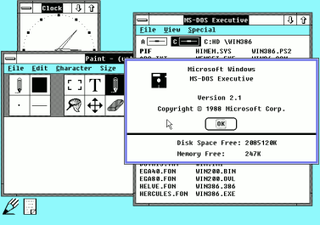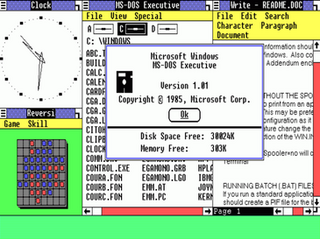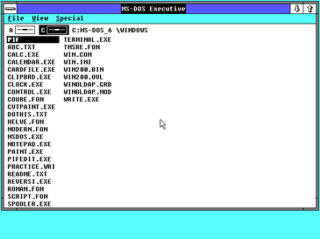
The Lattice C Compiler was released in June 1982 by Lifeboat Associates and was the first C compiler for the IBM Personal Computer. The compiler sold for $500 and would run on PC DOS or MS-DOS. The hardware requirements were 96KB of RAM and two floppy drives. It was ported to many other platforms, such as mainframes (MVS), minicomputers (VMS), workstations (UNIX), OS/2, the Commodore Amiga, Atari ST and the Sinclair QL.

Directory Opus is a file manager program, originally written for the Amiga computer system in the early to mid-1990s. Commercial development on the version for the Amiga ceased in 1997. Directory Opus is still being actively developed and sold for the Microsoft Windows operating system by GPSoftware and there are open source releases of Directory Opus 4 and 5 for Amiga.
Interactive Systems Corporation was a US-based software company and the first vendor of the Unix operating system outside AT&T, operating from Santa Monica, California. It was founded in 1977 by Peter G. Weiner, a RAND Corporation researcher who had previously founded the Yale University computer science department and had been the Ph. D. advisor to Brian Kernighan, one of Unix's developers at AT&T. Weiner was joined by Heinz Lycklama, also a veteran of AT&T and previously the author of a Version 6 Unix port to the LSI-11 computer.
CommSuite 95 was a communications software suite of products launched by the Canadian software company Delrina in late 1995.
Photogenics is raster graphic editing software produced by Idruna Software.
Simeon was an IMAP4 email client by The Esys Corporation with support for IMSP and LDAP.
Meeting Maker is a cross-platform personal calendar and group scheduling software application from PeopleCube. First released in 1991 for Macintosh by ON Technology, support for other platforms followed in 1993 with Meeting Maker XP. Alongside Windows and Mac, native clients were released for OS/2 and Solaris and later also for other platforms. Some support was introduced also for mobile platforms like Apple Newton, PalmPilot and Windows CE. Although powerful, its user interface - aiming at uniformity across multiple platforms - was criticized as weak and not supporting all features of target platforms.
Aldus PhotoStyler is a graphics software developed by the Taiwanese company Ulead. Released in June 1991 as the first 24 bit image editor for Windows it was bought the same year by the Aldus Prepress group. Its main competition was Adobe Photoshop. Version 2.0 introduced new user interface and improved color calibration. PhotoStyler SE - lacking some features of the version 2.0 - was bundled with scanners like HP ScanJet. The product disappeared from the Adobe product line after Adobe acquired Aldus in 1994.

Windows 2.1 is a major release of Microsoft Windows. It was released to manufacturing on May 27, 1988, as a successor to Windows 2.0.

Windows 1.0 is the first major release of Microsoft Windows, a family of graphical operating systems for personal computers developed by Microsoft. It was first released to manufacturing in the United States on November 20, 1985, while the European version was released as Windows 1.02 in May 1986.

Windows 3.1 is a major release of Microsoft Windows. It was released to manufacturing on April 6, 1992, as a successor to Windows 3.0.

Windows 2.0 is a major release of Microsoft Windows, a family of graphical operating systems for personal computers developed by Microsoft. It was released to manufacturing on December 9, 1987, as a successor to Windows 1.0.
Microsoft Office shared tools are software components that are included in all Microsoft Office products.

The Sony Multimedia CD-ROM Player was a portable CD-ROM-based multimedia player produced by Sony and released in 1992. It was used to run reference software, such as electronic publications and encyclopedia. Before its release, both Sony representatives and the press referred to the device as the Sony Bookman; that name remained in use in later publications.
The Orchid Graphics Adapter is a graphics board for IBM PC compatible computers, released in 1982 by Orchid Technology.
LINDO is a software package for linear programming, integer programming, nonlinear programming, stochastic programming and global optimization.
Laplink was a proprietary piece of software developed by Mark Eppley and sold by Traveling Software, which is now LapLink Software, Inc. First available in 1983, LapLink was used to synchronize, copy, or move, files between two PCs, in an era before local area networks, using the parallel port and a LapLink cable or serial port and a null modem cable or USB and a USB adhoc network cable.

Calendar is a personal calendar application made by Microsoft for Microsoft Windows. It offers synchronization of calendars using Microsoft Exchange Server, Outlook.com Apple's iCloud calendar service, and Google Calendar. It supports the popular iCalendar format.
PerfectDisk is a defragmentation software product for Windows developed by Raxco.
Raxco Software Inc. is a Gaithersburg, Maryland software company. Founded in 1978, the company's products have been sold internationally.








